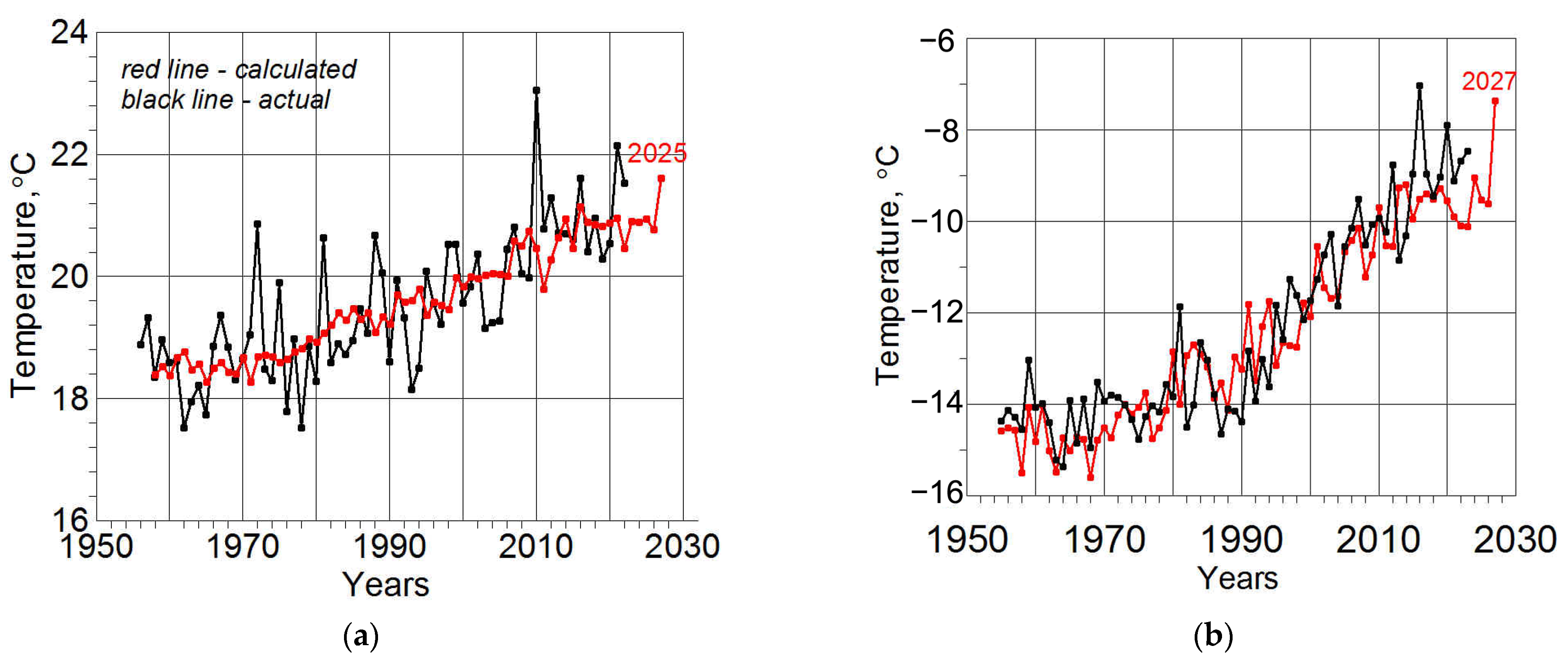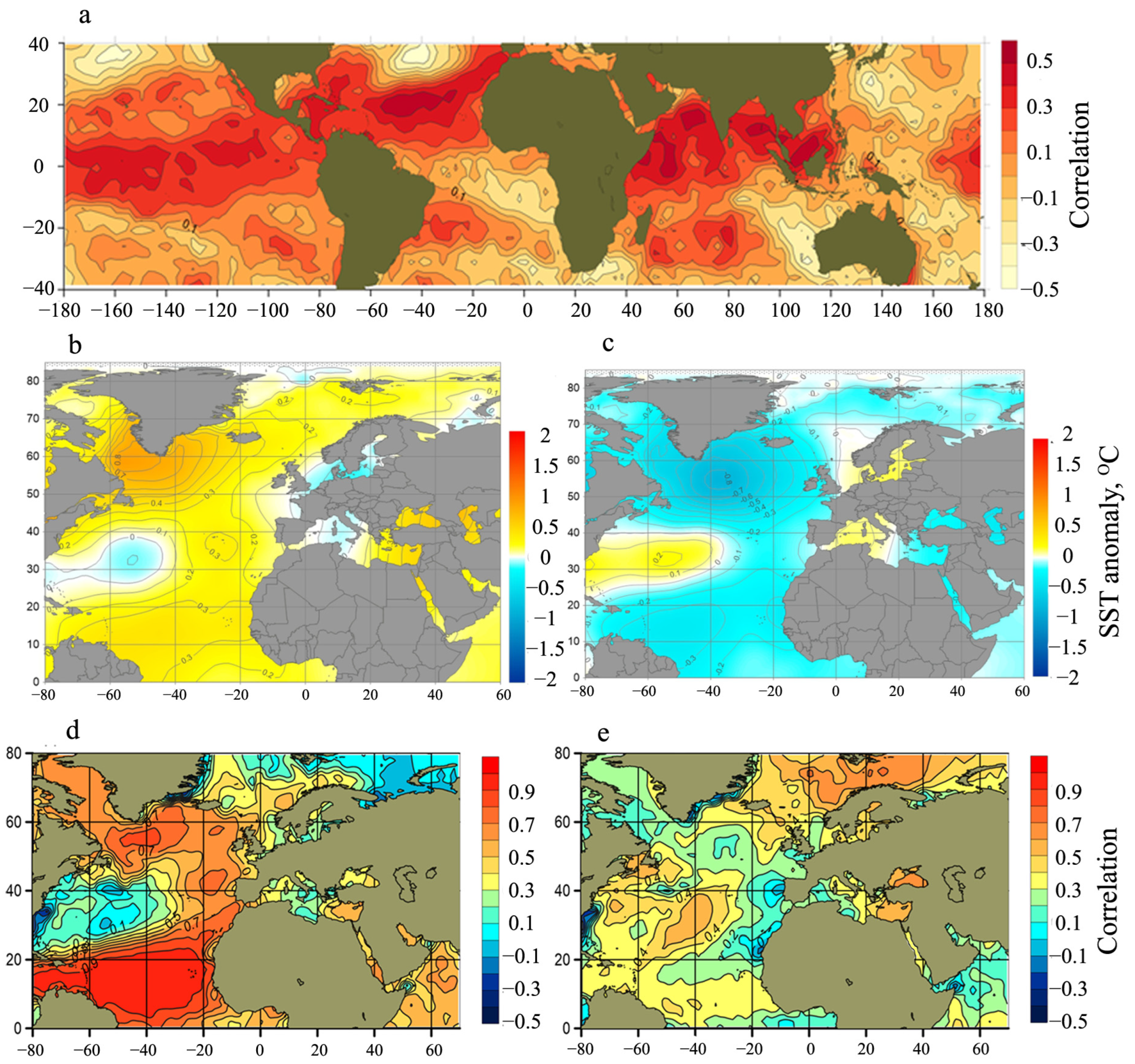Tropical Sea Surface Temperature and Sea Level as Candidate Predictors for Long-Range Weather and Climate Forecasting in Mid-to-High Latitudes
Abstract
1. Introduction
2. Materials and Methods
3. Results
4. Discussion
5. Conclusions
Author Contributions
Funding
Data Availability Statement
Acknowledgments
Conflicts of Interest
Abbreviations
| Mean surface air temperature in the Eastern European region (45–60° N, 20–60° E) in summer | |
| Mean surface air temperature in the Arctic in autumn | |
| Mean sea surface temperature anomaly in the Tropical North Atlantic (5.5–23.5° N, 15–57.5° N); | |
| Mean sea level at Manila South Harbour (14.5° N, 120.97° E) in autumn | |
| Time (in years) | |
| Summer season | |
| Autumn season | |
| R | Multiple regression coefficient |
| A (%) | Forecast accuracy on the dependent sample with an acceptable error of 0.674 standard deviation of the predictor |
| E (%) | Forecast efficiency on the dependent sample |
| Detrended multiple regression coefficient (trends removed from predictors and predictant) |
References
- Lorenz, E.N. The Nature and Theory of the General Circulation of the Atmosphere; World Meteorological Organization: Geneva, Switzerland, 1967; 161p. [Google Scholar]
- Golitsyn, G.S. A similarity approach to the general circulation of planetary atmospheres. Icarus 1970, 13, 1–24. [Google Scholar] [CrossRef]
- Hartmann, D.L. Global Physical Climatology; Academic Press: San Diego, CA, USA, 1994; 411p. [Google Scholar]
- Dymnikov, V.P.; Filatov, A.N. Mathematics of Climate Modeling; Birkhauser: Boston, MA, USA, 1997; 264p. [Google Scholar]
- Randall, D. An Introduction to the Global Circulation of the Atmosphere; Princeton University Press: Cambridge, MA, USA, 2015; 456p. [Google Scholar]
- Gulev, S.K.; Latif, M.; Keenlyside, N.; Park, W.; Koltermann, K.P. North Atlantic Ocean control on surface heat flux on multidecadal timescales. Nature 2013, 499, 464–467. [Google Scholar] [CrossRef] [PubMed]
- Schmitt, R.W. The ocean’s role in climate. Oceanography 2018, 31, 32–40. [Google Scholar] [CrossRef]
- Polonsky, A. The Ocean’s Role in Climate Change; Cambridge Scholars Publishing: Cambridge, UK, 2019; 294p. [Google Scholar]
- Williams, R.G.; Ceppi, P.; Roussenov, V.; Katavouta, A.; Meijers, A.J. The role of the Southern Ocean in the global climate response to carbon emissions. Phil. Trans. R. Soc. A 2023, 381, 20220062. [Google Scholar] [CrossRef]
- Ruprich-Robert, Y.; Moreno-Chamarro, E.; Levine, X.; Bellucci, A.; Cassou, C.; Castruccio, F.; Davini, P.; Eade, R.; Gastineau, G.; Hermanson, L.; et al. Impacts of Atlantic multidecadal variability on the tropical Pacific: A multi-model study. npj Clim. Atmos. Sci. 2021, 4, 33. [Google Scholar] [CrossRef]
- Årthun, M.; Eldevik, T.; Viste, E.; Drange, H.; Furevik, T.; Johnson, H.L.; Keenlyside, N.S. Skillful prediction of northern climate provided by the ocean. Nat. Commun. 2017, 8, 15875. [Google Scholar] [CrossRef] [PubMed]
- Smith, D.M.; Eade, R.; Scaife, A.A.; Caron, L.-P.; Danabasoglu, G.; DelSole, T.M.; Delworth, T.; Doblas-Reyes, F.J.; Dunstone, N.J.; Hermanson, L.; et al. Robust skill of decadal climate predictions. npj Clim. Atmos. Sci. 2019, 2, 13. [Google Scholar] [CrossRef]
- Hoerling, M.P.; Hurrell, J.W.; Xu, T. Tropical origins for recent North Atlantic climate change. Science 2001, 292, 90–92. [Google Scholar] [CrossRef]
- Årthun, M.; Eldevik, T. On anomalous ocean heat transport toward the Arctic and associated climate predictability. J. Clim. 2016, 29, 689–704. [Google Scholar] [CrossRef]
- Alekseev, G.V.; Glok, N.I.; Vyazilova, A.E.; Kharlanenkova, N.E.; Kulakov, M.Y. Influence of SST in low latitudes on the Arctic Warming and sea ice. J. Mar. Sci. Eng. 2021, 9, 1145. [Google Scholar] [CrossRef]
- Wettstein, J.J.; Deser, C. Internal variability in projections of twenty-first-century Arctic sea ice loss: Role of the large-scale atmospheric circulation. J. Clim. 2014, 27, 527–550. [Google Scholar] [CrossRef]
- Ye, K.; Wu, R.; Liu, Y. Interdecadal change of Eurasian snow, surface temperature, and atmospheric circulation in the late 1980s. J. Geophys. Res. Atmos. 2015, 120, 2738–2753. [Google Scholar] [CrossRef]
- Ding, Q.; Wallace, J.M.; Battisti, D.S.; Steig, E.J.; Gallant, A.J.E.; Kim, H.-J.; Geng, L. Tropical forcing of the recent rapid Arctic warming in northeastern Canada and Greenland. Nature 2014, 509, 209–212. [Google Scholar] [CrossRef] [PubMed]
- Goss, M.; Feldstein, S.B.; Lee, S. Stationary wave interface and its relation to tropical convection and Arctic warming. J. Clim. 2016, 16, 1369–1389. [Google Scholar] [CrossRef]
- Yoo, C.; Feldstein, S.B.; Lee, S. The impact of Madden-Julian Oscillation trend on the Arctic amplification ofsurface air temperature during 1979–2008 boreal winter. Geopjys. Res. Lett. 2011, 3, L24804. [Google Scholar]
- Yoo, C.; Lee, S.; Feldstein, S.B. Arctic response to an MJO-like tropical heating in an idealized GCM. J. Atmos. Sci. 2012, 69, 2379–2393. [Google Scholar] [CrossRef]
- Hou, Y.; Johnson, N.C.; Chang, C.; Sun, W.; Man, K.; Miao, Y.; Li, X. Cold Springs Over Mid-Latitude North America Induced by Tropical Atlantic Warming. Geophys. Res. Lett. 2023, 50, e2023GL104180. [Google Scholar] [CrossRef]
- Meehl, G.A.; Chung, C.T.Y.; Arblaster, J.M.; Holland, M.M.; Bitz, C.M. Tropical decadal variability and the rate of Arctic sea ice decrease. Geopjys. Res. Lett. 2018, 45, 11326–11333. [Google Scholar] [CrossRef]
- Yu, L.; Zhong, S.; Vihma, T.; Ding, S.; Sui, C.; Sun, B. The IPWP as a capacitor for autumn sea ice loss in Northeastern Canada. npj Clim. Atmos. Sci. 2024, 7, 259. [Google Scholar] [CrossRef]
- Alekseev, G.V.; Vyazilova, A.E.; Glok, N.I.; Ivanov, N.E.; Kharlanenkova, N.E. The effect of water temperature anomalies at low latitudes of the ocean on Arctic climate variations and their predictability. Arct. Ecol. Econ. 2019, 3, 73–83. [Google Scholar] [CrossRef]
- Alekseev, G.; Kuzmina, S.; Bobylev, L.; Urazgildeeva, A.; Gnatiuk, N. Impact of atmospheric heat and moisture transport on the Arctic warming. Int. J. Climatol. 2019, 39, 3582–3592. [Google Scholar] [CrossRef]
- Nesterov, E.S. North Atlantic Oscillation: Atmosphere and Ocean; Hydrometcenter Publishing: Moscow, Russia, 2013; 144p. [Google Scholar]
- Semenov, V.A.; Shelekhova, E.A.; Mokhov, I.I.; Zuev, V.V.; Koltermann, K.P. The influence of the Atlantic long-period oscillation on the formation of anomalous climatic regimes in the regions of northern Eurasia according to model calculations. Proc. Acad. Sci. 2014, 459, 742–745. [Google Scholar]
- De Deckker, P. The Indo-Pacific Waem Pool: Critical to world oceanography and world climate. Geosci. Lett. 2016, 3, 20. [Google Scholar] [CrossRef]
- Nesterov, E.S. Variability of atmospheric and ocean characteristics in the Atlantic-European region during El Niño and La Niña events. Meteorol. Hydrol. 2000, 8, 74–83. [Google Scholar]
- Mokhov, I.I.; Smirnov, D.A. Study of the mutual influence of the El Niño-Southern Oscillation and the North Atlantic and Arctic Oscillations. Proc. Acad. Sci. 2006, 42, 650–667. [Google Scholar] [CrossRef]
- Masson-Delmotte, V.; Zhai, P.; Pirani, A.; Connors, S.L.; Péan, C.; Berger, S.; Caud, N.; Chen, Y.; Goldfarb, L.; Gomis, M.I.; et al. (Eds.) IPCC, 2021: Climate Change 2021: The Physical Science Basis. In Contribution of Working Group I to the Sixth Assessment Report of the Intergovernmental Panel on Climate Change; Cambridge University Press: Cambridge, UK; New York, NY, USA, 2021; 2391p. [Google Scholar]
- Malinin, V.N.; Smirnov, M.A. Variability of the sea level in the tropical zone of the Pacific Ocean and El Niño-Southern Oscillation. Hydrometeorol. Ecol. 2022, 68, 463–477. [Google Scholar]
- Kalnay, E.; Kanamitsu, M.; Kistler, R.; Collins, W.; Deaven, D.; Gandin, L.; Iredell, M.; Saha, S.; White, G.; Woollen, J.; et al. The NCEP/NCAR 40-year reanalysis project. Bull. Amer. Meteor. Soc. 1996, 77, 437–471. [Google Scholar] [CrossRef]
- The NCEP/NCAR Reanalysis Project at the NOAA Physical Sciences Laboratory. Available online: https://psl.noaa.gov/data/reanalysis/reanalysis.shtml (accessed on 20 January 2021).
- Dee, D.P.; Uppala, S.M.; Simmons, A.J.; Berrisford, P.; Poli, P.; Kobayashi, S.; Andrae, U.; Balmaseda, M.A.; Balsamo, G.; Bauer, P.; et al. The ERA-Interim reanalysis: Configuration and performance of the data assimilation system. Q. J. R. Meteorol. Soc. 2011, 137, 553–597. [Google Scholar] [CrossRef]
- ECMWF Reanalysis—Interim (ERA—Interim). Available online: https://www.ecmwf.int/en/forecasts/dataset/ecmwf-reanalysis-interim (accessed on 21 January 2021).
- Hadley Centre Sea Ice and Sea Surface Temperature Data Set (HadISST). Available online: https://www.metoffice.gov.uk/hadobs/hadisst (accessed on 21 January 2021).
- Permanent Service for Mean Sea Level (PSMSL) Data. Available online: https://psmsl.org/data/ (accessed on 20 February 2024).
- All-Russian Research Institute of Hydrometeorological Information—World Data Centre. Available online: http://meteo.ru/data/ (accessed on 10 February 2024).
- Enfield, D.B.; Mestas-Nuñez, A.M.; Mayer, D.A.; Cid-Serrano, L. How ubiquitous is the dipole relationship in tropical Atlantic sea surface temperatures. J. Geophys. Res. Ocean 1999, 104, 7841–7848. [Google Scholar] [CrossRef]










| Sea Level Anomaly | Average Seasonal Surface Air Temperature | Data Source | ||
|---|---|---|---|---|
| 45–60° N, 20–60° E, Eastern Europe | 70–90° N Arctic | 70–90° N, 120–180° E Eastern Arctic | ||
| “TNA”, autumn | 0.56 (+2) summer | 0.74 (+4) autumn | 0.66 (+3) autumn | HadlSST, NCEP 1950–2023 |
| Key West SL, autumn | 0.60 (+3) summer | 0.77 (+4) autumn | 0.77 (+3) autumn | PMSL, NCEP 1950–2023 |
| Manila sea level, autumn | 0.72 (+6) summer | 0.84 (+6) autumn | 0.81 (+5) autumn | PMSL, NCEP 1950–2023 |
| Sea Level Anomaly | Average Seasonal Surface Air Temperature | Data Source | ||
|---|---|---|---|---|
| 45–60° N, 20–60° E, Eastern Europe | 70–90° N Arctic | 70–90° N, 120–180° E Eastern Arctic | ||
| “TNA”, autumn | 0.60 (+2) summer | 0.74 (+4) autumn | 0.72 (+3) autumn | HadlSST, ERA5 1950–2023 |
| Key West SL, autumn | 0.54 (+3) summer | 0.79 (+4) autumn | 0.73 (+3) autumn | PMSL, ERA5 1950–2023 |
| Manila sea level, autumn | 0.83 (+6) summer | 0.83 (+6) autumn | 0.77 (+5) autumn | PMSL, ERA5 1950–2023 |
| Regression Equations | Characteristics | |||
|---|---|---|---|---|
| R | A (%) | E (%) | ||
| 0.74 | 76 | 31 | 0.20 | |
| 0.91 | 98 | 28 | 0.52 | |
Disclaimer/Publisher’s Note: The statements, opinions and data contained in all publications are solely those of the individual author(s) and contributor(s) and not of MDPI and/or the editor(s). MDPI and/or the editor(s) disclaim responsibility for any injury to people or property resulting from any ideas, methods, instructions or products referred to in the content. |
© 2025 by the authors. Licensee MDPI, Basel, Switzerland. This article is an open access article distributed under the terms and conditions of the Creative Commons Attribution (CC BY) license (https://creativecommons.org/licenses/by/4.0/).
Share and Cite
Alekseev, G.; Soldatenko, S.; Glok, N.; Kharlanenkova, N.; Angudovich, Y.; Smirnov, M. Tropical Sea Surface Temperature and Sea Level as Candidate Predictors for Long-Range Weather and Climate Forecasting in Mid-to-High Latitudes. Climate 2025, 13, 84. https://doi.org/10.3390/cli13050084
Alekseev G, Soldatenko S, Glok N, Kharlanenkova N, Angudovich Y, Smirnov M. Tropical Sea Surface Temperature and Sea Level as Candidate Predictors for Long-Range Weather and Climate Forecasting in Mid-to-High Latitudes. Climate. 2025; 13(5):84. https://doi.org/10.3390/cli13050084
Chicago/Turabian StyleAlekseev, Genrikh, Sergei Soldatenko, Natalia Glok, Natalia Kharlanenkova, Yaromir Angudovich, and Maksim Smirnov. 2025. "Tropical Sea Surface Temperature and Sea Level as Candidate Predictors for Long-Range Weather and Climate Forecasting in Mid-to-High Latitudes" Climate 13, no. 5: 84. https://doi.org/10.3390/cli13050084
APA StyleAlekseev, G., Soldatenko, S., Glok, N., Kharlanenkova, N., Angudovich, Y., & Smirnov, M. (2025). Tropical Sea Surface Temperature and Sea Level as Candidate Predictors for Long-Range Weather and Climate Forecasting in Mid-to-High Latitudes. Climate, 13(5), 84. https://doi.org/10.3390/cli13050084








